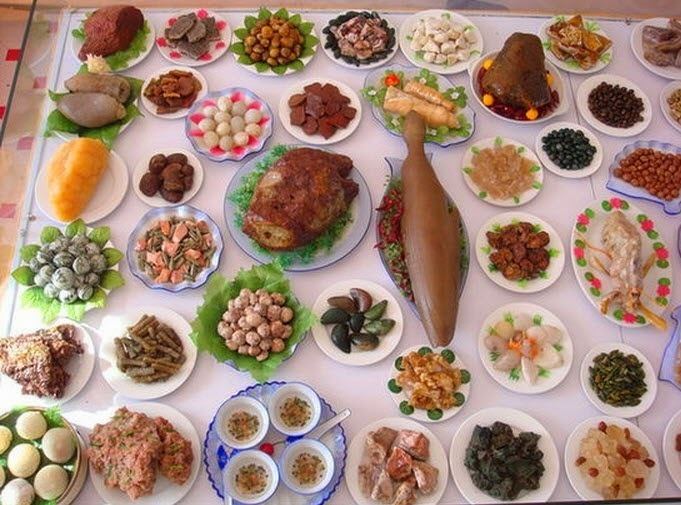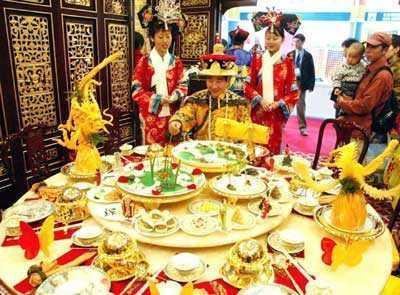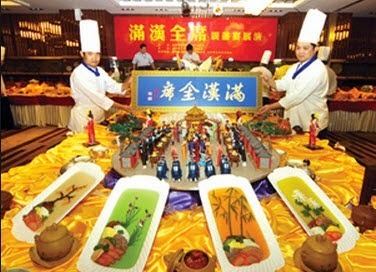Traditional Chinese 滿漢全席 Hanyu Pinyin Wade–Giles Man³han⁴ ch'üan²hsi² | Simplified Chinese 满汉全席 Bopomofo ㄇㄢˇ ㄏㄢˋ ㄑㄩㄢˊ ㄒㄧˊ Romanization Moehoe ziezih | |
 | ||
Similar Buddha Jumps Over the, Shark fin soup, Chinese cuisine, Lychee, Lao Gan Ma | ||
Manchu han imperial feast
Manhan Quanxi, literally Manchu Han Imperial Feast was one of the grandest meals ever documented in Chinese cuisine. It consisted of at least 108 unique dishes from the Manchu and Han Chinese culture during the Qing dynasty, and it is only reserved and intended for the Emperors. The meal was held for three whole days, across six banquets. The culinary skills consisted of cooking methods from all over Imperial China.
Contents
- Manchu han imperial feast
- Manchu han imperial feast sculpture
- Names
- Qing dynasty
- Preparation
- The meal
- Utensils
- In popular culture
- Replicas
- References

Manchu han imperial feast sculpture
Names
Quite a number of English names have been used to describe the dish combinations.
Qing dynasty

When the Manchus conquered China and founded the Qing dynasty, the Manchu and Han Chinese peoples struggled for power. The Kangxi Emperor wanted to resolve the disputes so he held a banquet during his 66th birthday celebrations. The banquet consisted of Manchu and Han dishes, with officials from both ethnic groups attending the banquet together. After the Wuchang Uprising, common people learned about the imperial banquet. The original meal was served in the Forbidden City in Beijing.
Preparation

The meal was prepared comprising six banquets over three days with over 300 dishes. Altogether there are said to have been 196 main dishes and 124 snack dishes, for a total of 320 dishes sampled over three days. Depending on how the dishes are counted with the samples, at the absolute minimum there were 108 dishes. The Emperor, after previewing the dishes, gave the feast its present name. The feast was divided into inner-palace and outer-palace banquets; only the imperial family and meritorious officials, including Han officials above the second rank, were invited into the inner-palace banquets. A book from the Qianlong era gives a detailed description of the feast and the dishes and ingredients.
The meal
It is said that there were "Thirty-Two Delicacies", referring to the more exotic ingredients used for the banquet. The "Eight Mountain Delicacies" includes such dishes as camel's hump, bear's paws, monkey's brains, ape's lips, leopard fetuses, rhinoceros tails and deer tendons. The "Eight Land Delicacies" includes several precious fowls and mushrooms, and the "Eight Sea Delicacies" includes dried sea cucumbers, shark's fin, bird's nest and others.
Some of the individual names of the dishes within:

Utensils

The utensils, like the food, were also lavish; the majority of utensils were finely crafted bronzeware, and porcelainware in the shape of many animals were designed with mechanisms for keeping the dishes warm throughout the meal. In general the Manchu dishes were first sampled, followed by the Han dishes.
In popular culture
The imperial meal was re-enacted in the movie The Chinese Feast and the television drama Happy Ever After. It is also featured in the anime Cooking Master Boy and the television series My Fair Princess as well as in chapters 106 and 142 of the Medaka Box manga.
In modern times, the Chinese term "Manhan Quanxi" can be used as an idiomatic expression to represent any feast of significant proportions. As an example, various media outlets may refer to a dinner gala as "Manhan Quanxi", while in China there are also numerous cooking competitions which make use of the aforementioned name, while not specifically referring to the original meaning of the imperial feast. The name is also used extensively in product names in the food industry, such usage evident as brands of sauces and instant noodles by various companies.
An abridged version of the Cantonese version of the imperial meal was depicted in Mister Ajikko, where the dessert: Almond Tofu dessert is used as a contest against the expert in the dish: A corrupt monk in the Cuisine Temple.
An inspiration of the imperial meal was re-enacted in Kung Fu Panda Holiday.
Replicas
The cuisine is extremely rare in China today, and if offered it is by a large margin one of the most expensive meals in the entire collection of Chinese cuisines, even in the late 80's, it was estimated to cost over 1 million yen then. Even when served, it is done with replacement ingredients, as many of the animals are essentially endangered species. Waiters serving the replicas are required to wear some form of traditional Chinese clothing.
